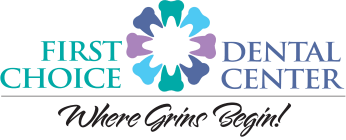ABOUT
About Us

Dr. Votteler
Dr. Votteler is a Louisville native and graduated from the University of Louisville School of Dentistry. She has over 21 years of experience under her belt with most of that being right here in her hometown. Her philosophy is a balance of tried and true procedures coupled with the advances of the latest technology but never losing focus on the best possible care for her patients.
Dr. Holly Votteler and her dental team provide dental treatments to meet the oral health and aesthetic goals of her patients. First Choice Dental Center in the Louisville area is a modern dental facility equipped with the latest in technology, while still maintaining a compassionate chairside manner.
The Team
Ashley
Accounts Manager
My name is Ashley. You can find me working in the front office as the Receptionist and Billing office. Outside of work, you can find me spending time with my two young daughters. I also enjoy spending my time reading, painting and hiking.
Maria
Expanded Dental Duties Assistant
My name is Maria. I attended University of Louisville and have been an Expanded Dental Duties Assistant for 20 years now. My husband and I have been married for 15 years and we have 3 children. We live on a farm and I love riding our horses in my spare time.
When a new patient joins our family, we strive to make their experience as enjoyable as possible. At the Louisville dental practice of Dr. Holly Votteler, our compassionate approach to oral health allows patients to feel relaxed and free to communicate concerns or issues they may have with the current state of their teeth. We have delivered quality dental care in Louisville for over 25-years, and we’re happy to continue to welcome families into our practice. Your oral health is our top priority.
Come Visit Us at First Choice Dental Center!

18 Sep, 2019
However, some young children need early intervention or Phase One treatment. This evaluation doesn’t necessarily mean orthodontics are needed right away. However, monitoring growth patterns can indicate the best opportunity to start treatment to get the best results. The American Association of Orthodontists recommends that your child has an initial screening at the age of seven, with formal orthodontics beginning around age nine. What Causes Orthodontic Problems? Some cases may be a matter of genetics or inherited orthodontic issues such as crowded teeth, excessive spacing, bad bites, or protruding teeth. Other cases may be due to injury, early or late loss of baby teeth, or habits like thumb sucking. Evaluating the Need for Early Treatment Some issues are easy to diagnose, and some developmental issues can correct themselves as children grow into their preteen years. It is important to have a professional determine if your child’s oral development is on track or if they need intervention. Some of the issues a dentist may evaluate include: Difficulty chewing or biting Thumb sucking after age five Mouth breathing Speech impediments Early or late loss of baby teeth Protruding teeth Shifting of the jaw when opening or closing (cross-bite) Crowded front teeth What is Phase One Treatment? The goal of early treatment is to help your child’s jaw to develop correctly, so there is plenty of room for their permanent. Partial braces, palatal expansion, space maintainers, or retainers can all be used to create more space and improve bone growth. These early intervention methods can help eliminate the need for corrective surgery later on and make regular orthodontic procedures shorter and more effective. Phase one treatment typically lasts about 10-14 months. Once it is complete, your child will be fitted with a retainer to keep everything in place until it is time to move on to phase two, then the next phase will begin around age 11 or older, after all, permanent teeth have erupted. Phase Two Orthodontic Treatment Once most of your child’s permanent teeth have erupted (around age 11 or older), phase two can begin. Most cases that require phase one treatment will also require a phase two. The second phase usually requires full braces or clear aligners and can begin once the 12-year molars are close to erupting. The braces or aligners will need to be carefully monitored for about 18-24 months. After this treatment is complete, a retainer will still need to be worn every night to prevent teeth from moving back to their original position. Simplify Orthodontics with Early Intervention Orthodontics, like most other dental and medical services are best used as a preventive measure. Beginning orthodontic treatment early can prevent the development of problems for your child in later years and can stave off costly restorative and reconstructive procedures. Early treatment may not apply to all orthodontic problems, but it can help in certain cases. Braces have improved dramatically over the past couple of decades, making them more comfortable and more effective. With proper planning, a child who has early orthodontics may enjoy better self-confidence, optimal tooth and bite function, improved tooth and jaw alignment, and more stable results.

18 Sep, 2019
DIY Whitening Toothpaste If you are a DIY fan, making your own toothpaste from baking soda and hydrogen peroxide can be highly effective and economical. Mix together one-part hydrogen peroxide and two parts baking soda for a bargain toothpaste that costs less than three dollars! If you want a ready to go option, look for a product in the super-market isle that contains these ingredients. The most important element here is to brush regularly, often, and with a soft toothbrush. To really step up your brushing game invest in an electric toothbrush. Not only do they remove plaque and stimulate gums better, but they also have timers to make sure you are brushing long enough. Whitening Mouth Rinses Before and After Brushing For a full rounded whitening routine, pre-rinse, floss, brush, then use mouthwash. The active ingredients in mouthwash loosen up buildup and food to make brushing and flossing more effective. A mouthwash after brushing gets into any gaps you’ve missed the first go around and allows the fluoride to soak into the enamel. A mouthwash that contains hydrogen peroxide and used at least twice a day for three months can significantly whiten teeth. Word of caution: avoid mouthwashes that are dark in color; the color can actually stain your teeth when the alcohol evaporates. Most companies who develop these products suggest a daily usage cycle of approximately twelve weeks in order to see expected results. Over-the-Counter Whitening Strips & Gels Whitening strips are extremely thin strips that are typically coated with a peroxide-based stain removal gel. Usually, you can expect initial results after a few days of use, with more complete results showing up after approximately four months of regular usage. Whitening gels can also be applied with an application brush directly to the surface of the teeth. The application directions will vary dependent upon the strength of the peroxide used in the particular tooth whitening product. Some dental experts suggest that whitening mouthwashes may not be quite as effective as other over the counter products because the mouthwash is only in direct contact with your teeth for as little as sixty seconds, whereas other products remain in contact with the enamel longer. For example, many tooth whitening strips suggest an application of 30 minutes or longer, or 60 times as long as a typical mouth rinse application. Due to this much shorter application cycle, mouth rinses may have less of a pronounced effect than other competing options. You may consider using a tooth whitening mouth rinse in addition to one or more of the other solutions rather than instead of them. This could provide a better result than using the mouth rinse product by itself. Tray-Based Whitening Systems Another tooth whitening option you might want to consider is the tray-based whitening system. These systems can be purchased either from your dentist or over-the-counter. They typically involve a mouth guard shaped tray and a tooth whitening solution that contains a peroxide enamel gel. Some pricier brands even use ultraviolet light to speed up the process. You generally wear this tray for a specified period of time ranging from a couple of hours per day to overnight. The directions may call for wearing this tray for the specified time daily for four weeks or longer, depending upon how discolored your teeth are and how many shades of whitening you desire. Professional Whitening Treatments Many dental offices offer professional in-office whitening treatment solutions. These solutions can often provide the quickest and most effective results relative to the other products listed in this article. However, they can also be the most expensive. Even with the improved effectiveness of professional dental office whitening solutions, you may still need multiple treatments to achieve the results you desire, so keep that in account when considering going with this option. Dental office treatments usually involve a whitening product that is applied directly to the teeth. The whitening solution is often combined with heat, light, or laser treatment as well. You can expect to see results in a single half-hour to one-hour treatment. To achieve more dramatic results, repeated appointments are often needed. The biggest advantage of going with a professional office treatment is that you can usually see results after one treatment, so if you need results quickly, this is often the best way to go, despite the higher price tag. The better you feel about your teeth, the more effort you will put into its care and maintenance. Whether you choose to go with toothpaste, gels, strips, rinses or dental office treatment, having whiter teeth can provide an excellent boost to personal confidence and improve the way you feel about your overall appearance and oral health.
QUICK LINKS
WORKING HOURS
- Monday
- Closed
- Tue, Thu
- -
- Wed, Fri
- -
- Sat - Sun
- Closed
© 2024
First Choice Dental Center | All Rights Reserved




